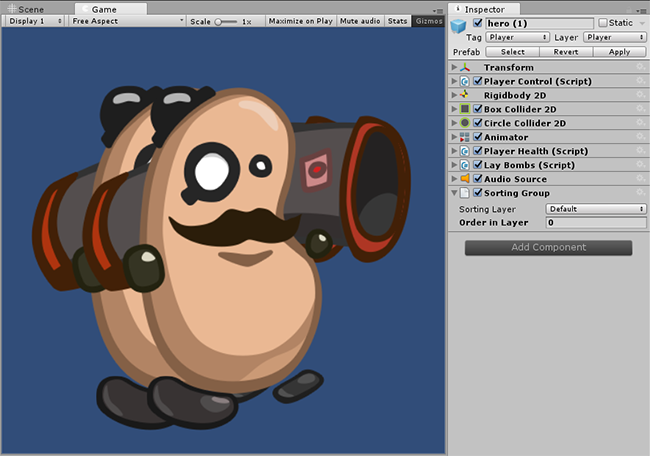Description
Adding a SortingGroup component to a GameObject will ensure that all Renderers within the GameObject's descendants will be sorted and rendered together.
A common use case for having a SortingGroup is to create complex 2D characters that are made up of multiple SpriteRenderers. When several clones of such a character overlap, their individual body parts might not be sorted properly resulting in a visual glitch where the the body parts interleave. For example, the hands of two characters might be sorted in front of their bodies, where you would expect one entire character to be drawn in front of the other character. The SortingGroup component solves this by ensuring the entire branch of the character are sorted and rendered together.
The descendants of the SortingGroup are sorted using the same SortingLayer and Renderer.sortingOrder. However, they are only sorted against other descendants of the SortingGroup and not with any renderers outside of it. This allows you to reuse the same SortingLayers (for example, "Hands", "Torso"...) to sort body parts while ensuring they never interleave with other clones of the character.
The SortingGroups, together with other renderers, are sorted using the SortingLayer and Renderer.sortingOrder. Additionally, they can be nested within other SortingGroups. This is useful if you have branches of descendants that should not be mixed up i.e. the "Left Hand" vs the "Right Hand" hierarchy branches.
 .
.
Variables
| sortingLayerID | Unique ID of the Renderer's sorting layer. |
| sortingLayerName | Name of the Renderer's sorting layer. |
| sortingOrder | Renderer's order within a sorting layer. |
Inherited members
Variables
| enabled | Включенное Поведение обновляется, выключенное Поведение не обновляется. |
| isActiveAndEnabled | Has the Behaviour had active and enabled called? |
| gameObject | Игровой объект к которому прикреплён данный компонент. Компонент всегда прикреплён к игровому объекту. |
| tag | Тег данного игрового объекта. |
| transform | The Transform attached to this GameObject. |
| hideFlags | Should the object be hidden, saved with the Scene or modifiable by the user? |
| name | The name of the object. |
Public Functions
| BroadcastMessage | Вызывает метод названный methodName на каждом MonoBehaviour этого game object-а или любого из его потомков. |
| CompareTag | Помечен ли данный игровой объект тегом tag? |
| GetComponent | Возвращает компонент типа type, если он прикреплен к игровому объекту и null, если не прикреплен. |
| GetComponentInChildren | Возвращает компонент типа type в GameObject или некоторого его потомка через поиск в глубину. |
| GetComponentInParent | Возвращает все компоненты типа type из GameObject'а или из любого его родителя. |
| GetComponents | Возвращает все компоненты типа type в GameObject. |
| GetComponentsInChildren | Возвращает все компоненты типа type в GameObject или любому из его потомков. |
| GetComponentsInParent | Возвращает все компоненты типа type в GameObject или любому из его родителей. |
| SendMessage | Вызывает метод с названием methodName в каждом MonoBehaviour в этом игровом объекте. |
| SendMessageUpwards | Вызывает метод с именем methodName в каждом MonoBehaviour в этом игровом объекте и в каждом предке поведения. |
| GetInstanceID | Returns the instance id of the object. |
| ToString | Returns the name of the object. |
Static Functions
| Destroy | Removes a GameObject, component or asset. |
| DestroyImmediate | Destroys the object obj immediately. You are strongly recommended to use Destroy instead. |
| DontDestroyOnLoad | Do not destroy the target Object when loading a new Scene. |
| FindObjectOfType | Returns the first active loaded object of Type type. |
| FindObjectsOfType | Returns a list of all active loaded objects of Type type. |
| Instantiate | Clones the object original and returns the clone. |
Operators
| bool | Does the object exist? |
| operator != | Compares if two objects refer to a different object. |
| operator == | Compares two object references to see if they refer to the same object. |